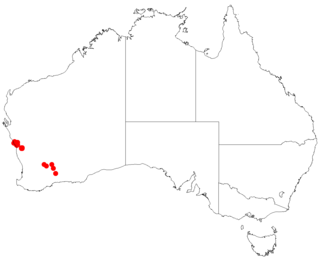
Styphelia marginata, commonly known as thick-margined leucopogon, is a species of flowering plant in the heath family Ericaceae and is endemic to the south-west of Western Australia. It is a dwarf shrub with lance-shaped leaves and white, tube-shaped flowers.

Styphelia foliosa, commonly known as candle cranberry, is a species of flowering plant in the family Ericaceae and is endemic to the Perth region of Western Australia.

Styphelia planifolia is a species of flowering plant in the heath family Ericaceae and is endemic to the south-west of Western Australia. It is a bushy shrub with narrowly oblong or lance-shaped leaves with a small, sharp point on the tip, and white, tube-shaped flowers.

Styphelia stomarrhena is a small shrub species in the family Ericaceae. It is found in Western Australia.
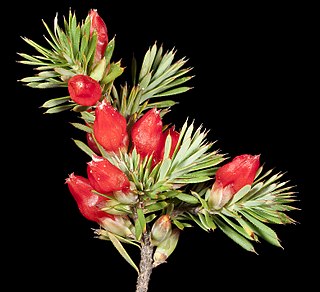
Styphelia tortifolia is a small shrub species in the family Ericaceae. It is found in Western Australia.
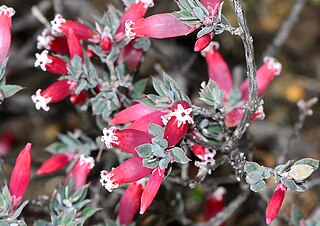
Styphelia stricta is a small plant in the family Ericaceae. It is endemic to Western Australia.
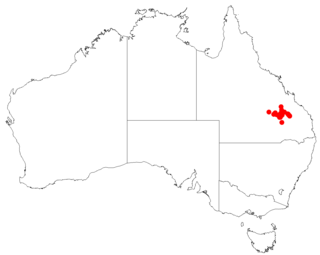
Styphelia grandiflora is a species of flowering plant in the heath family Ericaceae and is endemic to Carnarvon National Park in south-eastern Queensland. It is a shrub with softly-hairy branchlets, oblong leaves and white flowers.

Styphelia capillaris, commonly known as Horts' styphelia, is a species of flowering plant in the heath family Ericaceae and is endemic to a small area of south-western Western Australia. It is a dense, spreading shrub with narrowly egg-shaped to narrowly elliptic leaves and white flowers arranged singly or in pairs in leaf axils.
Styphelia angustiflora is a species of flowering plant in the heath family Ericaceae and is endemic to a small area near York, in the south-west of Western Australia. It is an erect, compact shrub with sharply-pointed, narrowly egg-shaped leaves and white, tube-shaped flowers.
Styphelia cernua is a species of flowering plant in the heath family Ericaceae and is endemic to a small area of Western Australia. It is an erect shrub with narrowly egg-shaped leaves with the narrower end towards the base, and white flowers arranged singly or in pairs in leaf axils.
Styphelia chlorantha is a species of flowering plant in the heath family Ericaceae and is endemic to a small area of Western Australia. It is a low, spreading shrub with erect, narrowly egg-shaped to egg-shaped leaves with the narrower end towards the base, and green, tube-shaped flowers arranged singly in leaf axils.

Styphelia acervata is a species of flowering plant in the heath family Ericaceae and is endemic to the south-west of Western Australia. It is a dense, prostrate, mat-forming shrub with erect, narrowly egg-shaped leaves, and cream-coloured and greenish tube-shaped flowers.
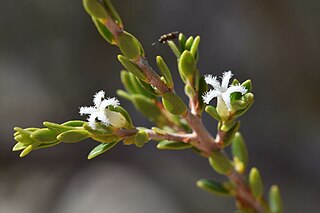
Styphelia ciliosa is a species of flowering plant in the heath family Ericaceae and is endemic to a small area of Western Australia. It is usually an erect shrub with narrowly elliptic to narrowly egg-shaped leaves with the narrower end towards the base, and white flowers usually arranged in pairs in leaf axils.
Styphelia decussata is a species of flowering plant in the heath family Ericaceae and is endemic to the south-west of Western Australia. It is a slender shrub with many branches, overlapping triangular to egg-shaped leaves, and white, tube-shaped flowers arranged singly in upper leaf axils.
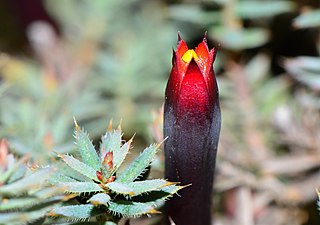
Styphelia discolor is a species of flowering plant in the heath family Ericaceae and is endemic to the south-west of Western Australia. It is a shrub, usually with prostrate stems and spreading, tapering linear leaves and almost sessile red flowers.
Styphelia disjuncta is a species of flowering plant in the heath family Ericaceae and is endemic to a small area in the south-west of Western Australia. It is an erect shrub with egg-shaped to narrowly egg-shaped leaves, and white, tube-shaped flowers arranged singly in leaf axils.
Styphelia filamentosa is a species of flowering plant in the heath family Ericaceae and is endemic to a small area in the south-west of Western Australia. It is a low, compact, spreading shrub with egg-shaped to narrowly elliptic leaves, and white, tube-shaped flowers arranged singly, or in groups of up to four in leaf axils.
Styphelia filifolia is a species of flowering plant in the heath family Ericaceae and is endemic to the south-west of Western Australia. It is an erect shrub with erect, linear leaves, and white, tube-shaped flowers arranged singly, or in groups of up to four in leaf axils.
Styphelia inopinata is a species of flowering plant in the heath family Ericaceae and is endemic to the west of Western Australia. It is a robust, spreading shrub with hairy young branchlets and usually erect, narrowly elliptic, sharply-pointed leaves and reddish pink, very narrowly bell-shaped flowers, usually arranged singly in leaf axils.
Styphelia longissima is a species of flowering plant in the heath family Ericaceae and is endemic to a few places in the south-west of Western Australia. It is an erect shrub with hairy young branchlets, stem-clasping, sharply-pointed, narrowly egg-shaped to narrowly elliptic leaves, and white, tube-shaped flowers.










